Scrawlzy is a UK artist with over 30 years of experience in exploring creativity and taking inspiration from past and present experiences to create conversations from art. Scrawlzy is both a digital and physical artist.
While maintaining his roots in painting, Scrawlzy seamlessly integrates his ideas into the digital realm, providing insightful commentary on the practicalities of art, such as pricing strategies and considerations for aspiring artists. Always willing to engage with the art community, he is a strong advocate for art as an expressive outlet and champions the importance of continuous learning and creating at every opportunity.
A master at his craft, Scrawlzy continues to inspire with his thoughtful perspectives on the viewing experience of digital art, addressing the nuances of digital display, including aspect ratios and the potential for large-scale presentations. His innovative approach to art, commitment to honing his craft, and openness to adapting to the rapidly changing artistic landscape make him a distinguished voice in the global art scene.
Listen to/Watch the Interview
Visit Scrawlzy’s MakersPlace Storefront
Meet Scrawlzy
Brady Walker: Scrawlzy, welcome. Your bio reveals that you’ve been an active artist for over 30 years. Could you shed light on your creative practice before NFTs came into the picture?
Scrawlzy: Essentially, not much has changed. My inspiration and approach to each artwork or asset remains the same. I usually start with a spark of inspiration that I plan to incorporate into a future piece. This spark might come from a conversation, something I’ve observed or heard, often music. There’s always something stimulating in the background when I paint, predominantly music. Whether it’s a physical piece, a sketch, or digital, the process begins with this inspiration, a desire to breathe life into a canvas. This journey continues until the piece is complete.
While I avoid oil paints due to the waiting time for drying, my preferred mediums are acrylics and sprays for physical artwork. For digital creations, there’s no concern for dry time, which allows me to just dive in and finish. Despite the consistency in my creative process, the web3 space demands that I wear many hats: a marketing manager, a social media manager, a curator, among others. This added responsibility does consume more time, but it also brings a new level of excitement, learning, and inspiration.
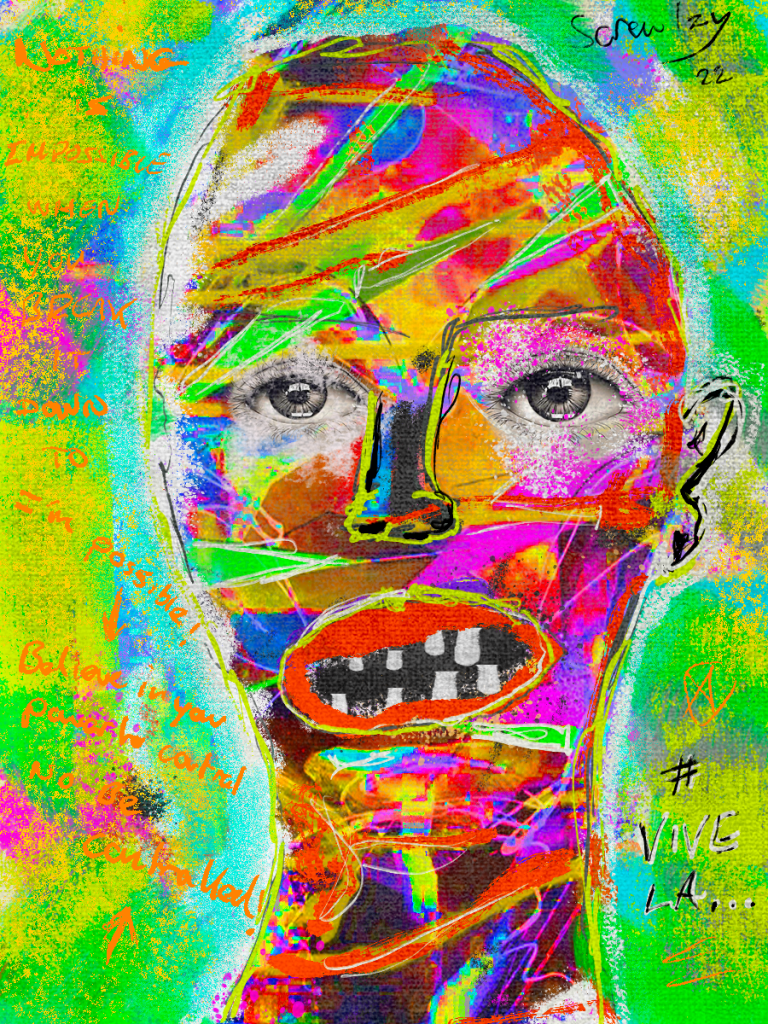
Freedom Regained by Scrawlzy
Scrawlzy’s Journey Beyond Perfectionism
Brady Walker: Would you mind taking a step back to introduce yourself to our readers and listeners who may not be familiar with your work?
Scrawlzy: Certainly. I’m Scrawlzy, real name Andy, a creator for over 30 years, both in physical and digital formats. One of my earliest inspirations was Jean-Michel Basquiat, whose work taught me that art need not be perfect. A portrait, for instance, doesn’t require symmetrical features in their ‘correct’ places. The idea of ‘perfection’ is a construct that often hinders creativity, a notion I try to avoid.
My art teacher further instilled in me this sense of freedom, alleviating the pressure to emulate the masters. Typically, I draw inspiration from music and conversations. For a long time, my mantra has been “creating art from conversations and conversations from art.” The primary aim for each work isn’t necessarily for viewers to understand my thoughts at the time, but rather to stimulate conversation.
In fact, my ultimate goal is to incite dialogue between two strangers over my work. Regardless of whether their opinion is positive or negative, it’s their conversation that matters. My longstanding mindset has always been centered on creating conversations through art.
Brady Walker: I’m curious about your art teacher’s influence in freeing you from the constraints of perfectionism. Could you tell us more about that?
Scrawlzy: Absolutely. We often hold ourselves back in the pursuit of perfection. I used to get frustrated trying to make my paintings match the image I had in my head. My art teacher was brilliant. He was relaxed and supportive, always encouraging experimental approaches.
One day, he placed me in front of an easel with three pieces of paper, a brush, and some paint, then asked if he could blindfold me. With the whole class watching, he blindfolded me, aligned me with the paper, and instructed me to paint. Without sight, I painted a portrait. Of course, the features were all over the place. But that experience showed me that I didn’t need to stress over perfect alignment or placement.
He used that exercise to explain to the class that we humans are not symmetrical, that one ear might be higher or larger, or one arm slightly longer. This insight was a revelation for me. It was a concept I’d never considered before. I began practicing with this newfound freedom in mind.
While he taught the curriculum, he also introduced us to avant-garde artists like Basquiat. He encouraged us to envision what we could achieve if we continued our artistic journeys beyond school. That revelation ultimately shaped the artist I am today.
Brady Walker: There’s something profound about experiencing a piece of art, be it a painting, a book, or a film, and realizing that there are no rules. That feeling of, “Wait, you can do that?”
Scrawlzy: Absolutely.
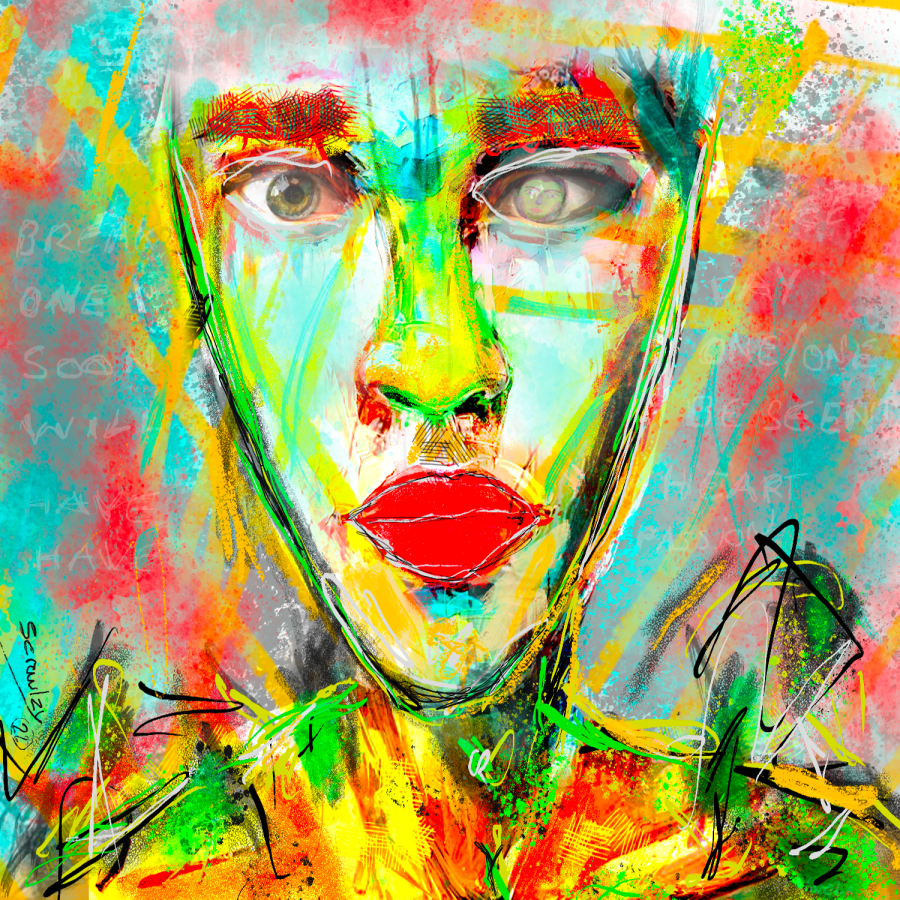
Depth of Vision by Scrawlzy
Brady Walker: It’s transformative when done well. Now, regarding your sources of inspiration, what kind of music are you currently into?
Scrawlzy: I have quite an eclectic taste, ranging from Queen to Beanie Man, Collie Budds, and Tupac. However, the primary genre I listen to is reggae, something I grew up with in a multicultural area of the UK. I’ve always gravitated towards reggae, so artists like Collie Budds, who is also in the NFT space, are typically on my playlist. I’ve had several conversations with him, which I found inspiring. He’s incredibly humble and down-to-earth, which has sparked some of my recent art. Generally, I enjoy a mix of light rock or reggae.
The Unseen Layers of Scrawlzy’s Artistic Process
Brady Walker: What was the last piece of art you had a conversation about?
Scrawlzy: Funnily enough, today we discussed a piece I made on the timeline. I composed some poetry inspired by a poetry space on Twitter and created the artwork for it afterward. I shared it with a few people and then on the timeline. I also shared the spoken word version by slightly modifying the artwork. This sparked comments from Block Muse and others, leading to a brief conversation. I still haven’t titled the piece; titles usually come to me later after looking at the piece more or discussing it.
Brady Walker: So, the title evolves from impressions you and others derive from the piece?
Scrawlzy: Exactly, it’s a feeling that emerges. Sometimes the title comes during creation, or when I sign the piece, other times, I’ll set the piece aside, contemplate it, and look deeper. Occasionally, a conversation will provide the spark for the title.
Brady Walker: How much sketching or preparation goes into creating your work?
Scrawlzy: There’s minimal sketching. The inspiration to start a piece, whether digital or physical, motivates me to work from start to finish. My style often conceals hidden elements in the artwork. These elements, like peculiar things in the eyes or the background, engage people and spark conversations. While I occasionally sketch ideas for ‘assets’ like little characters or text additions, I generally work on a piece from start to finish without much planning.
‘Scrawlism’: A Manifesto of Artistic Freedom
Brady Walker: Let’s return to your next project. Can you share more about it?
Scrawlzy: Certainly. For my upcoming drop, I have a piece that includes some very rough sketches. My idea is to create an animation showing these sketches across the canvas, instead of a typical work-in-progress video. While I’m not an animator by training, I’ve taken it upon myself to learn through doing. I plan to animate the progression from raw sketches to the finished piece. It’s a new venture for me and will undoubtedly keep me busy for some time.
Unspoken Chains by Scrawlzy
Brady Walker: That sounds intriguing. Earlier, you mentioned characters. Do any of them recur in your work?
Scrawlzy: Yes, they do. During my younger days, I did a lot of graffiti, often using spray cans from the local car spare store. One character that has persisted from those times is a little blue robot named ‘Mintobot.’ He’s a reimagined version of a character I used to sketch during my school days. I’ve started to introduce him and other characters from those days into my current pieces, where they pop up in corners or in the background. Their recurrence has become part of my artistic brand.
Brady Walker: Speaking of your brand, can you tell us more about ‘Scrawlism’?
Scrawlzy: For me, ‘Scrawlism’ represents freedom. It’s not about getting every line perfect or coloring inside the lines. If I accidentally make a splash somewhere, that’s okay. Scrawlism is about the liberty to let my strokes flow wherever they want, much like abstract art.
Juxtaposition is Storytelling
Brady Walker: Could you elaborate on your piece, Life Can Change in the Blink of an Eye?
Scrawlzy: “Life Can Change in the Blink of an Eye” is the sole animated piece from my “Life of Art” series, comprising five pieces in total. The inspiration comes from old horror movies and comedy sketches where you’d see the eyes of portraits move. I started contemplating if art has a life of its own, shaped by people’s perceptions, its value, or its mystery.
As technology advances, we discover hidden elements beneath layers of paint in many masterpieces – something that adds to their intrigue. This line of thought led to the creation of a portrait within a frame, with a body added to it. As I’m learning animation, I animated the eyes in the smaller portrait on the left. The main character appears to be walking through a gallery, as if an art piece itself is exploring what’s on the walls.
LIFE CAN CHANGE IN THE BLINK OF AN EYE by Scrawlzy
Brady Walker: That’s fascinating. Art can spark conversations, interacting with other pieces. When two pieces are juxtaposed, they create a different vibe, like forming a sentence.
Scrawlzy: Absolutely. When such interactions occur serendipitously, it feels magical. On a few occasions, I’ve created pieces from different series, and when I’ve placed them together, they’ve taken on a new life, inspiring an entirely new series. One piece of art can indeed transform any other at any given moment.
Reflections on Past, Present, and Future
Brady Walker: I’ve been looking at some of your MakersPlace pieces and I’m curious about Two Souls, which you created in May 2021. The text on it reads, “When two souls meet, they will see through pain and mass. They will see the true beauty inside.” Given the time of completion, what was going on when you created this?
Scrawlzy: At that time, I was reflecting a lot. I’ve been married for 11 years this year.
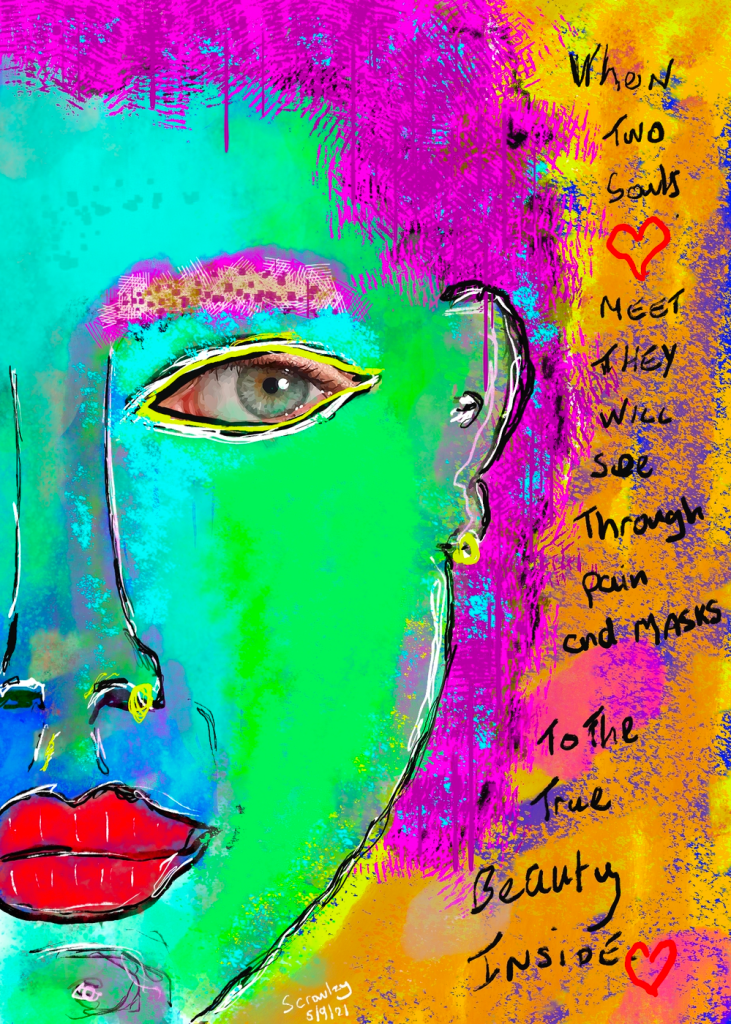
Brady Walker: Mazel tov.
Scrawlzy: Thank you very much. My meeting and dating my wife was very organic, effortless, with no rush. The concept of “two souls” stems from the realization, thanks to each other, that baggage from the past can be irrelevant in a new relationship. Dwelling too much on the past can potentially harm the future. That piece was inspired by a conversation about how we’d helped each other move past everything that came before so we could focus on moving forward.
Brady Walker: That’s beautiful. This year, I’ve been delving into Buddhism and Buddhist philosophy. The notion that the past only exists in our minds is quite liberating once you fully understand it (not to say that I do!).
Scrawlzy: It’s interesting that you bring that up. I don’t often watch social media, but I came across an Instagram reel recently where someone discussed this very idea – that the past only exists in our minds and the future isn’t here yet. We only have the present and we create the future daily. This thought intrigued me and will likely inspire an art piece in the future. When something piques my interest, it often becomes a source of inspiration.
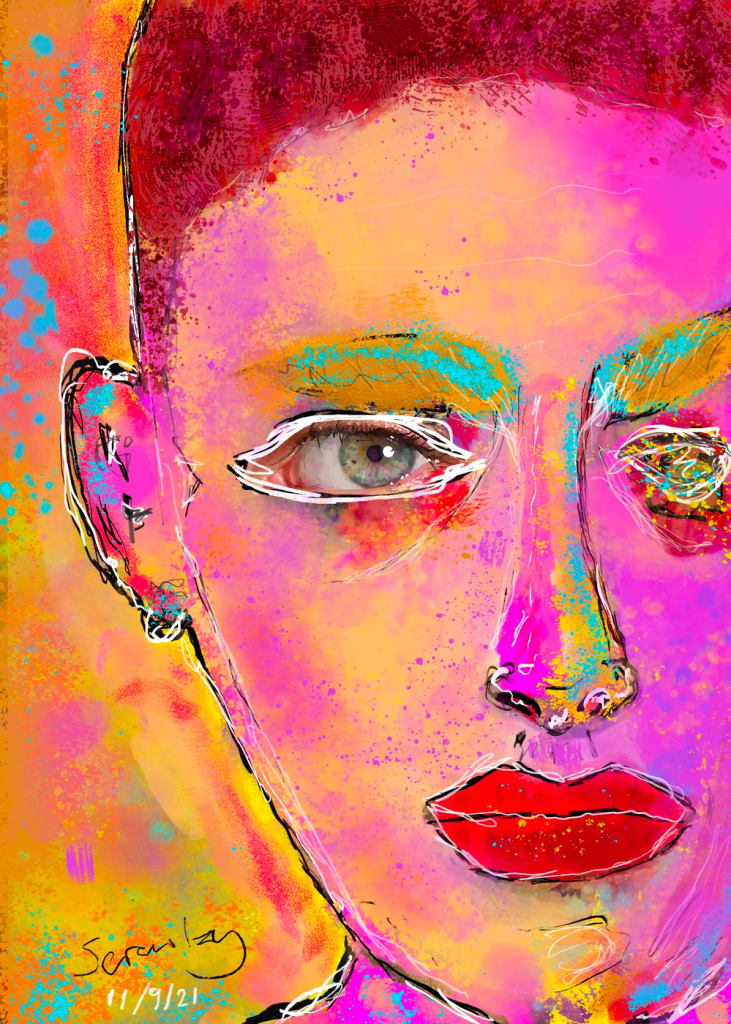
Market vs Artist
Brady Walker: Your Foundation piece, Market vs. Artist, is quite intriguing. As someone transitioning from being a nights-and-weekends artist to a full-time artist, how do you navigate the market’s fluctuations?
Scrawlzy: For me, creation comes first. Before NFTs, I created primarily for myself, to manifest my ideas and inspirations onto a canvas or a digital platform. I don’t overly concern myself with the market’s volatility. Ups and downs are inherent to any selling platform, be it galleries, art fairs, or craft fairs. My focus is on creating, honing my skills, learning new things, and building a body of work. I understand that the market can be tough, especially for artists relying solely on the Web3 NFT platform for their art sales. Luckily, I also work, so I don’t bear the burden of worrying about sales all the time. This gives me more freedom. “Market vs. Artist” was inspired by the fluctuating state of the market, including the effects of the Twitter algorithm. The boxing gloves in the piece symbolize the battle between the ever-changing market and the artist.
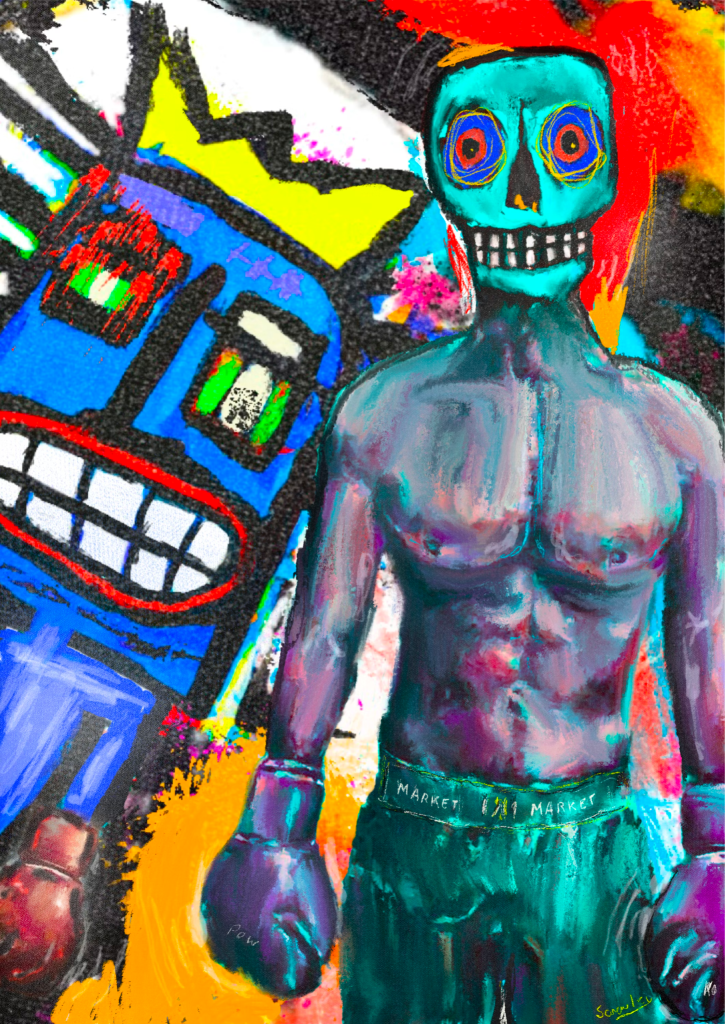
Market vs. Artist by Scrawlzy
Brady Walker: It sometimes feels like the Twitter algorithm is part of the market.
Scrawlzy: Indeed. The recurring character, Mintobot, represents artists who are constantly minting for sales or for blockchain record-keeping. These artists are always trying to understand the market and how to increase their visibility. The boxer, on the other hand, symbolizes the market—slightly larger, more imposing, ready to shake things up, whether through algorithm changes or fluctuations in crypto coins and gas fees.
Brady Walker: Gas fees are a market factor quietly undermining many artists. How do you approach minting? How frequently do you mint? If you could estimate, what percentage of your creations do you actually mint?
Scrawlzy: That’s an interesting question. I’d say I mint around 20 to 25% of what I create. My minting pattern tends to happen in spurts; I’ll have periods where I mint a lot, followed by periods of inactivity. This depends on several factors such as the current state of the market and my personal schedule. However, I certainly create more than I mint. I’ve considered minting all my works as a kind of record or diary of my creations. Perhaps I’ll do that someday, maybe even minting them on my own contract. No one knows what the future holds, and I’d like to leave a legacy for my three children. If they’re all on the blockchain, they’re permanently recorded. But the bottom line is I mint far less than people might assume.
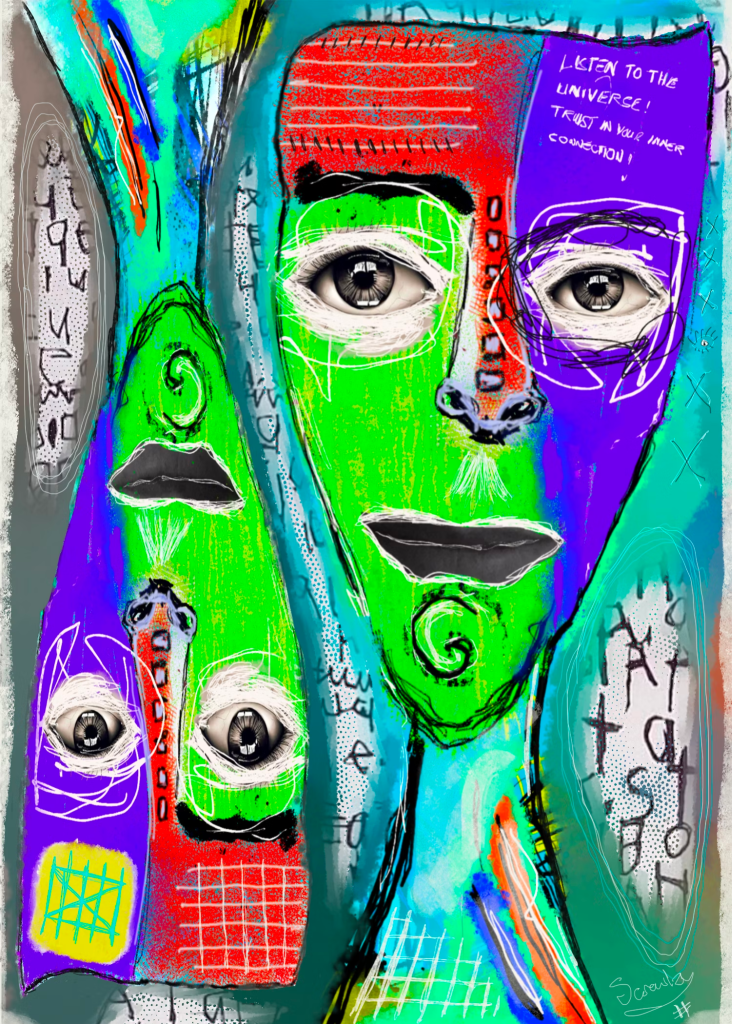
Gemini by Scrawlzy
Family, Work, and Art: Striking the Balance
Brady Walker: As someone juggling a full-time job, three children, and a prolific artistic output, when do you find time to paint?
Scrawlzy: Well, I manage my time meticulously. My routine revolves around work, spending time with my children, and fulfilling other commitments like interviews, social media engagement, and participating in Twitter spaces. My teenage children have their interests, giving me some free time. During Twitter spaces, which can last from 30 minutes to a couple of hours, I often paint. My youngest child is quite adept with my iPad and enjoys painting as well. Thus, painting also doubles as quality time with him. We’ve even done a collaboration currently displayed on the Tezos platform. So, despite the busyness of family life, I always find time to paint.
Brady Walker: That’s the beauty of art—it’s a shared activity. As a writer, it’s more challenging to involve others in the process.
Scrawlzy: I can see that. Maintaining a train of thought might be difficult with little ones around. But with painting, even crayons and paint can be part of the fun.
Art and Audience: Inviting Discovery and Conversation
Brady Walker: I’m keen to learn about your intentions regarding audience experience. Specifically, whether you aim to provide a specific experience or allow for a more undefined takeaway. Often, your work incorporates text, either on the piece itself or in the meta description.
Scrawlzy: I like to believe I’m setting the audience up for discovery—discovery of a fresh way of thinking or perceiving something unseen before. I like to engage their curiosity, nudging them to probe deeper because they’ve noticed a subtle element, compelling them to uncover more hidden layers, whether that be text or a concealed portrait. As for audience participation, my ultimate goal is to stimulate conversation, not necessarily about my art, but between individuals. Society has transformed to an extent where casual conversations with strangers are becoming rare, especially here in the UK. I aim to encourage those spontaneous interactions again. A brief chat can significantly alter someone’s mood, especially if they’re feeling low or stressed. A conversation with a stranger can offer a refreshing perspective and momentarily distract them from their concerns. So, if anything, I hope to inspire such interactions through my work.
Brady Walker: I resonate with that. Over the past 10 months, I’ve had the privilege of interviewing more than 80 artists and collectors in this space. The art of interviewing has been a remarkable journey of discovery for me. Although it may seem self-serving as I get to ask all the questions without sharing much about myself, I concur that the conversational aspect of life is something we need to prioritize. Many of us, including myself, work from home, and there are days when we don’t venture outside, which is a shared reality for many.
Scrawlzy: Indeed, the COVID-19 pandemic exemplified how quickly loneliness can creep in unnoticed. If you’re home-based, making a brief trip to the local store doesn’t necessarily involve much social interaction, which can make one feel isolated. This is where the Web3 space, particularly Twitter spaces, plays an invaluable role by connecting people globally. A short interaction can significantly impact someone’s day, maybe even prompt them to engage in a conversation they initially intended to avoid, thus creating opportunities to forge new connections. It’s crucial not to let the art of conversation slip away.
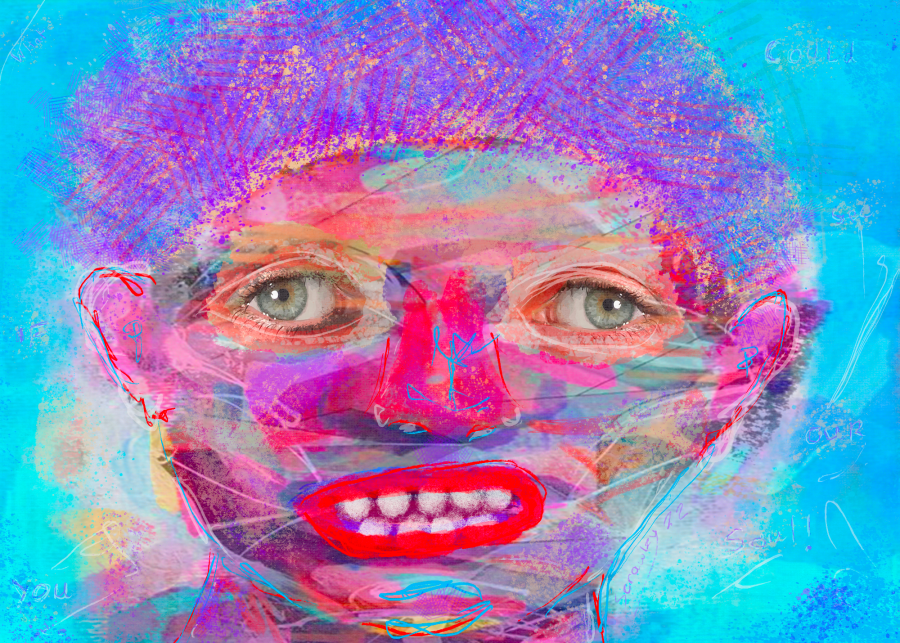
Translucence by Scrawlzy
Navigating Art Sales: Survival, Valuation, and Appreciation
Brady Walker: I’d like to steer this discussion towards generating advice for other artists, especially concerning pricing, which tends to be a daunting aspect for new artists entering the space. How do you approach this?
Scrawlzy: Pricing can be tricky and is usually dependent on how reliant you are on art sales or NFT sales for your living. If you’re in a position where art sales directly affect your ability to pay bills or put food on the table, you might price your work lower. And that’s perfectly fine. No one should be shamed for pricing their work according to their needs. My journey began with pricing at around $200. Over time, it has fluctuated based on the complexity and the time taken to complete each piece.
Some pieces, being less complex, are completed quickly and priced lower, while others with more intricate elements are priced higher. For artists wrestling with pricing, consider your circumstances. Why and how urgently do you need to sell? It’s okay to price lower if you need to pay rent, but don’t undervalue your work. Consider the total time invested in the piece, including downloading and uploading files and minting the piece. Set a baseline hourly rate for yourself, say $10 or $20, and calculate from there. You’ll find a balance. The market can be inconsistent, and prices may vary depending on whether you base them on Ethereum or dollars, but start by assessing your needs and work from there.
Brady Walker: Being a digital artist, how do you envision your viewers experiencing your art daily? You also paint, so perhaps your audience enjoys the physical painting. But for digital art, how should they appreciate it?
Scrawlzy: Many collectors buy pieces because they want to support the artist, although they may not wish to view the piece every day. However, for those who want to enjoy the artwork regularly, viewing it on a larger screen or a digital frame would be ideal. This way, they can appreciate the details and textures. Alternatively, they could print it. I offer the file to anyone who purchases my work, so they can have it printed in any format or size they prefer. I’d love to see my work displayed on larger screens, even on a colossal screen like those in Times Square! That would be a fantastic sight. But generally, I believe the best way to enjoy digital art is on a large digital screen.
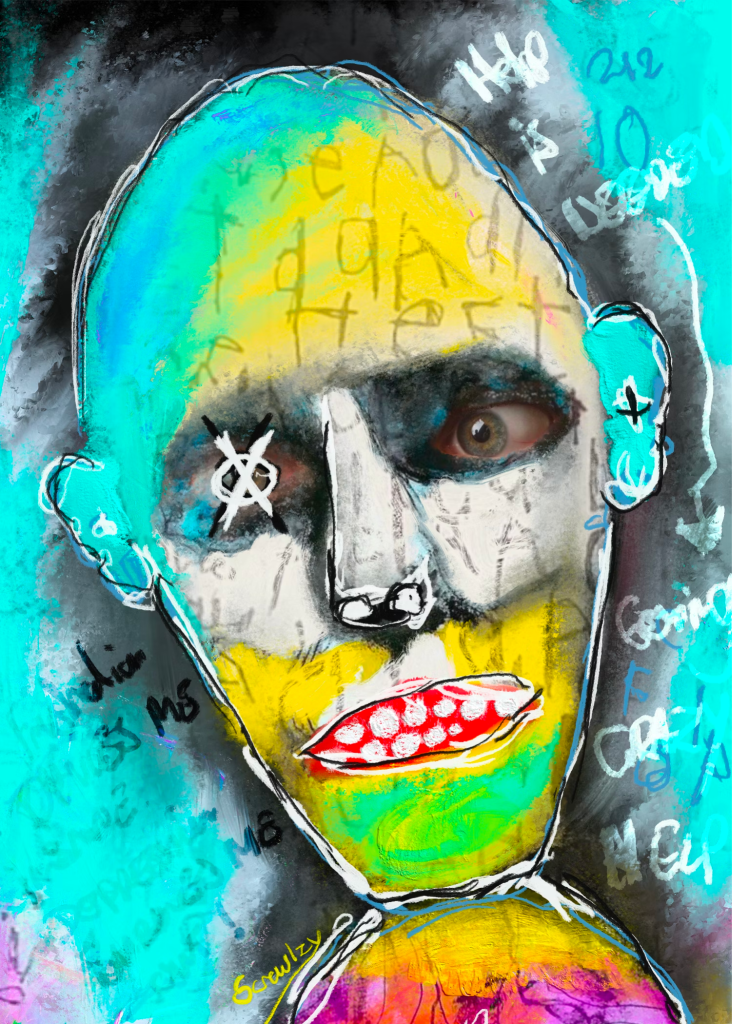
Darkness inside by Scrawlzy
Brady Walker: In creating your digital art, do you consider the aspect ratio?
Scrawlzy: When I first began creating digital art, I didn’t think much about the aspect ratio. I was more focused on conveying my ideas and inspiration. My art has always been an outlet for me, not necessarily made for selling. However, as I continue to learn and grow, I’ve realized the importance of the aspect ratio, especially if the art is to be displayed on large billboards or screens. I want my art to look its best for everyone who purchases it, whether it’s a limited edition or a one-of-one. It’s all part of the learning curve.
Never Stop Learning: Embracing Constant Creativity
Brady Walker: Earlier, we discussed the revelation you had about freedom of expression, influenced by your art teacher and artists like Basquiat. If you could give your 20-year-old self advice about creativity, apart from the freedom to express, what would you say?
Scrawlzy: I’d tell myself to create more, seize every chance to create using any materials available. If all you have is mud, then paint with mud, because it’s all a part of learning. The two most critical pieces of advice would be to create wherever and whenever possible and to never stop learning. Years later, you may realize you wish you’d learned something when you were younger. So, it’s important to embrace continuous learning and creativity, despite life’s other commitments.
For updates on all our artist features, subscribe to our newsletter below 👇
- SEO Powered Content & PR Distribution. Get Amplified Today.
- PlatoAiStream. Web3 Data Intelligence. Knowledge Amplified. Access Here.
- Minting the Future w Adryenn Ashley. Access Here.
- Buy and Sell Shares in PRE-IPO Companies with PREIPO®. Access Here.
- Source: https://rare.makersplace.com/2023/05/29/creative-abandon-career-strategies-and-the-move-from-paint-to-digital-interview-with-scrawlzy/?utm_source=rss&utm_medium=rss&utm_campaign=creative-abandon-career-strategies-and-the-move-from-paint-to-digital-interview-with-scrawlzy



